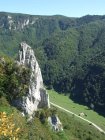Administrație
- Constituire Administraţie
- Consiliul Stiinţific
- Consiliul Consultativ de Administrare
- Comitetul Director
- Regulament parc
- Plan management
Despre parc
- Constituire parc
- Localizare şi acces
- Hărți
- Geologie, Geomorfologie
- Hidrologie, Climă, Soluri
- Floră, Faună
Turism
Brief
Translation by courtesy of Elisabeth Turk
Grădiștea Muncelului - Cioclovina represents a protected area with the status of “natural park.” Its scope is to protect and conserve the natural habitat with respect to fauna, flora, forestry, hydrology, geology, speology, paleontology and pedology.
The park focuses on sustainable conservation of natural resources, landscapes and local tradition.
The park was founded at the judicial level in 1979 and reconfirmed in 1997. In 2000, with the beginning of the law nr. 5/2000, PNGM-C was declared a protected natural area of national interest. According to the OUG 57/2007 regarding the regime for natural protected habitats and wild faunistic and floristic habitats, the Park was integrated into the IUCN category 5.
PNGM-C Natural Park is situated in the massive Șureanu Mountains, with the Orăștie Mountains and Sebeşului Mountains as subdivisions. The borders are: the Haţeg Valley to the west and the Orăştie Valley to the north. The land within the park’s border includes large forested areas, steps, meadows, fields, carstic zones, water courses, historical monuments, archeological sites, and human settlements.
For whoever wanders for the first time through PNGM-C, the landscape becomes strikingly charming through the variety of reliefs, through the combination of ancient Dacian history, and through the ethnographic diversity so specific to the villages from here. This zone reveals the obvious touristic attraction for all; among the various mountains, valleys, rivers, and breath-taking scenery spotted with ancient ruins, one encounters a natural landscape of unsurpassed beauty.
Natural Park Touristic Objectives
- Caves and vertical caves: Ponorici, Cioclovina cu Apă, Peştera Bolii, Pălăriei, Șura Mică, Tecuri, Sifonul de la Șipot, etc.
- Cheile Crivadiei Natural Reservation, highly valued for its landscape and flora
- Ohaba Ponor Fossilized Point
- Ponor and Ponorici meadows where water from the Ponor and Ponorici rivers is frozen to the depths of the earth, disappearing under a rock wall and after circulating for several kilometres, emerges to the surface in Șura Mare, Șura Mică and Cioclovina, respectively.
- Bordu Mare
- Strei Valley
- Numerous species of flora and fauna
Anthropological Touristic Objectives
- Historical monuments of national and international value (included in the UNESCO Patrimony): “the heart of the Dacian civilization” – Sarmizegetusa Regia – the citadel of the seat of the Dacian kings, in conjunction with the following citadels: Costeşti, Blidaru, Feţele Albe, Vârful lui Hulpe, Piatra Roșie, and Bănița
- Customs and traditions (nedei, măsuratul oilor, păstorit)
Other Touristic Sites Near the Park
- Water mill from Ludești, within the commune Orăștioara de Sus.
- Ethnographic Museum from Orăștie.
- Retezat National Park.
- Colț Medieval Citadel and Monastery, Suseni – Râu de Mori.
- Dinosaur Geopark – Țara Hațegului.
- Sântămăria Orlea Castle, 13th Century, restored as a hotel.
- Aurel Vlaicu Memorial House.
- Dacian and Roman Civilization Museum – Deva.
- Mining Museum of Petroșani.
- Simeria Dendrological Park.
- Huniazilor Castle of Hunedoara.
- Geogiu-Băi Resort with Roman thermal waters.
- Roman Camp from Cigmău.
- Densuș Church.
Rules and Regulations
- In Grădiștea Muncelului-Cioclovina Natural Park, permitted activities within the scope of tourism and education are present in accordance with visitation regulations.
- Access points in the PNGM-C are Costești, Măgureni, Boșorod, Pui, Ponor, Baru, Crivadia, Streiului Valley and Băniței Valley.
- PNGM-C is only open to visit via public access roads and tourist routes marked with specific conventional signs, in compliance with certain restrictions.
- Camping for tourists within APNGM-C is only allowed in certain locations indicated by the park administration.
- Camping in places other than those provided is only allowed in special circumstances (research, exploration, rescue, etc...) with the administration’s approval.
- Within camp sites, the following in prohibited:
- digging ditches around the tents or use of any material of plant origin (pine needles, fern, moss) under the tents
- construction of camp fires sites outside of those provided by the camp administrator (denoted by a circle of stones)
- purchase of firewood outside of that provided by the camp administrator
- destruction or degradation of informative panels or signs demarking travel routes is prohibited
- degradation of shelters, bridges, or any other building or tourist facility within the park is strictly forbidden
Environmental Conduct
We recommend the following while visiting the park:- Tourists must follow marked touristic paths and may not wander into unmarked territory.
- Camp only in the designated areas and use camp fire sites (indicated with a circle of stones) instead of a camping or portable stove.
- Admire the plants and flowers from a distance. If you cut and take them, they will not withstand the car ride home.
- Trees are living beings. Please only take picture of them.
- Please respect the historical monuments and do not scratch or mark them. They are a testimony to our heritage.
- Take your garbage and food debris with you and dispose of them in the proper waste facilities provided.






